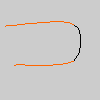 |
 |
 |
 |
| Name |
|
curve() |
 |
|
|
| Examples |
|
 |
stroke(255, 102, 0);
curve(5, 26, 5, 26, 73, 24, 73, 61);
stroke(0);
curve(5, 26, 73, 24, 73, 61, 15, 65);
stroke(255, 102, 0);
curve(73, 24, 73, 61, 15, 65, 15, 65);
|
 |
|
| Description |
|
Draws a curved line on the screen. The first and second parameters specify the first anchor point and the last two parameters specify the second anchor. The middle parameters specify the points for defining the shape of the curve. Longer curves can be created by putting a series of curve() functions together. An additional function called curveTightness() provides control for the visual quality of the curve. The curve() function is an implementation of Catmull-Rom splines. Using the 3D version of requires rendering with P3D or OPENGL (see the Environment reference for more information). |
 |
|
|
| Syntax |
|
curve(x1, y1, x2, y2, x3, y3, x4, y4);
curve(x1, y1, z1, x2, y2, z2, x3, y3, z3, x4, y4, z4);
|
 |
|
|
| Parameters |
|
| x1, y1, z1 |
|
int or float: coordinates for the first anchor
|
| x2, y2, z2 |
|
int or float: coordinates for the first point
|
| x3, y3, z3 |
|
int or float: coordinates for the second point
|
| x4, y4, z4 |
|
int or float: coordinates for the second anchor
|
|
 |
|
|
| Returns |
|
None |
 |
|
|
| Usage |
|
Web & Application |
 |
|
|
| Related |
|
curveVertex()
bezier()
|
|
|


